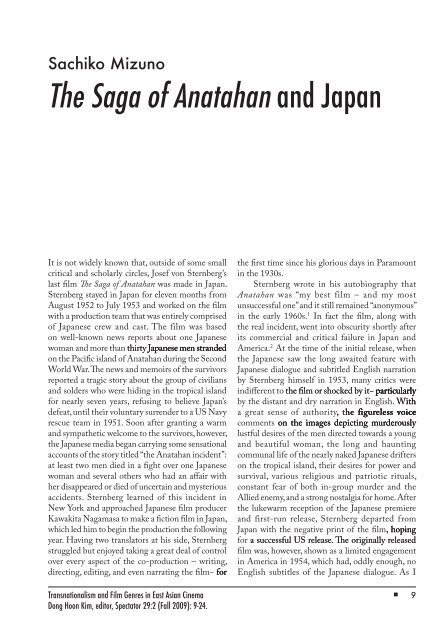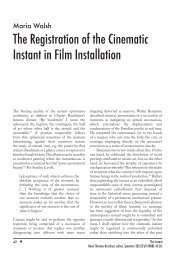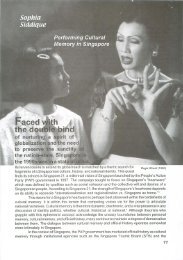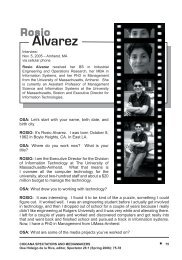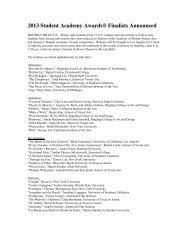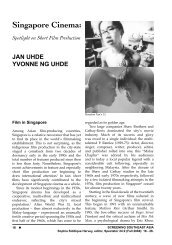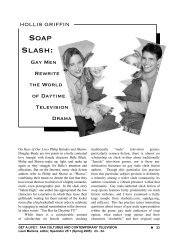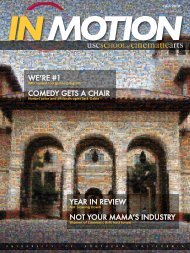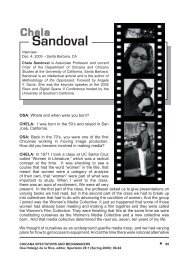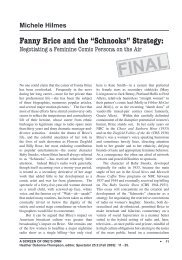The Saga of Anatahan and Japan - USC School of Cinematic Arts
The Saga of Anatahan and Japan - USC School of Cinematic Arts
The Saga of Anatahan and Japan - USC School of Cinematic Arts
You also want an ePaper? Increase the reach of your titles
YUMPU automatically turns print PDFs into web optimized ePapers that Google loves.
Sachiko Mizuno<br />
<strong>The</strong> <strong>Saga</strong> <strong>of</strong> <strong>Anatahan</strong> <strong>and</strong> <strong>Japan</strong><br />
It is not widely nown that, outside <strong>of</strong> some small<br />
critical <strong>and</strong> scholarly circles, Josef on Sternberg’s<br />
last film <strong>The</strong> <strong>Saga</strong> <strong>of</strong> <strong>Anatahan</strong> was made in <strong>Japan</strong>.<br />
Sternberg stayed in <strong>Japan</strong> for eleen months from<br />
August 1952 to July 1953 <strong>and</strong> wored on the film<br />
with a production team that was entirely comprised<br />
<strong>of</strong> <strong>Japan</strong>ese crew <strong>and</strong> cast. <strong>The</strong> film was based<br />
on well-nown news reports about one <strong>Japan</strong>ese<br />
woman <strong>and</strong> more than thirty <strong>Japan</strong>ese men str<strong>and</strong>ed<br />
on the Pacific isl<strong>and</strong> <strong>of</strong> <strong>Anatahan</strong> during the Second<br />
orld ar. e news <strong>and</strong> memoirs <strong>of</strong> the suriors<br />
reported a tragic story about the group <strong>of</strong> ciilians<br />
<strong>and</strong> solders who were hiding in the tropical isl<strong>and</strong><br />
for nearly seen years, refusing to beliee <strong>Japan</strong>’s<br />
defeat, until their oluntary surrender to a S Nay<br />
rescue team in 1951. Soon after granting a warm<br />
<strong>and</strong> sympathetic welcome to the suriors, howeer,<br />
the <strong>Japan</strong>ese media began carrying some sensational<br />
accounts <strong>of</strong> the story titled “the <strong>Anatahan</strong> incident”:<br />
at least two men died in a fight oer one <strong>Japan</strong>ese<br />
woman <strong>and</strong> seeral others who had an affair with<br />
her disappeared or died <strong>of</strong> uncertain <strong>and</strong> mysterious<br />
accidents. Sternberg learned <strong>of</strong> this incident in<br />
New Yor <strong>and</strong> approached <strong>Japan</strong>ese film producer<br />
Kawaita Nagamasa to mae a fiction film in <strong>Japan</strong>,<br />
which led him to begin the production the following<br />
year. Haing two translators at his side, Sternberg<br />
struggled but enjoyed taing a great deal <strong>of</strong> control<br />
oer eery aspect <strong>of</strong> the co-production – writing,<br />
directing, editing, <strong>and</strong> een narrating the film for<br />
Transnationalism <strong>and</strong> Film Genres in East Asian Cinema<br />
Dong Hoon Kim, editor, Spectator 29:2 (Fall 2009): 9-24.<br />
the first time since his glorious days in Paramount<br />
in the 1930s.<br />
Sternberg wrote in his autobiography that<br />
<strong>Anatahan</strong> was “my best film – <strong>and</strong> my most<br />
unsuccessful one” <strong>and</strong> it still remained “anonymous”<br />
in the early 1960s. 1 In fact the film, along with<br />
the real incident, went into obscurity shortly after<br />
its commercial <strong>and</strong> critical failure in <strong>Japan</strong> <strong>and</strong><br />
America. 2 At the time <strong>of</strong> the initial release, when<br />
the <strong>Japan</strong>ese saw the long awaited feature with<br />
<strong>Japan</strong>ese dialogue <strong>and</strong> subtitled English narration<br />
by Sternberg himself in 1953, many critics were<br />
indifferent to the film or shoced shoced by it it particularly<br />
particularly<br />
by the distant <strong>and</strong> dry narration in English. ith ith ith<br />
a great sense <strong>of</strong> authority, , the he figureless oice oice oice oice oice<br />
comments on on the the images images depicting depicting murderously<br />
murderously<br />
lustful desires <strong>of</strong> the men directed towards a young<br />
<strong>and</strong> beautiful woman, the long <strong>and</strong> haunting<br />
communal life <strong>of</strong> the nearly naed <strong>Japan</strong>ese drifters<br />
on the tropical isl<strong>and</strong>, their desires for power <strong>and</strong><br />
surial, arious religious <strong>and</strong> patriotic rituals,<br />
constant fear <strong>of</strong> both in-group murder <strong>and</strong> the<br />
Allied enemy, <strong>and</strong> a strong nostalgia for home. After<br />
the luewarm reception <strong>of</strong> the <strong>Japan</strong>ese premiere<br />
<strong>and</strong> first-run release, Sternberg departed from<br />
<strong>Japan</strong> with the negatie print <strong>of</strong> the film, , hoping<br />
for a successful S S release. e e originally released<br />
film was, howeer, shown as a limited engagement<br />
in America in 1954, which had, oddly enough, no<br />
English subtitles <strong>of</strong> the <strong>Japan</strong>ese dialogue. As I
SAGA oF AnATAHAn AnD JApAn<br />
elaborate later, the curious fate <strong>of</strong> this is “anonymous<br />
film” did not end here. n n n the one h<strong>and</strong>, in <strong>Japan</strong><br />
Kawaita waita aita replaced the problematic narration with<br />
a young English-speaing <strong>Japan</strong>ese man in order<br />
to maret the film in Europe. n the other h<strong>and</strong>,<br />
in America Sternberg later re-edited the film with<br />
newly shot footage, hoping for a more successful rerelease<br />
in the S. Although <strong>Anatahan</strong> went further<br />
into obscurity particularly after Sternberg’s death<br />
in 1969, as a result <strong>of</strong> the multiple ersions <strong>of</strong> the<br />
film that emerged, it actually opened up questions<br />
<strong>of</strong> authorship, authenticity, <strong>and</strong> originality.<br />
is article traces the history <strong>of</strong> the longforgotten<br />
<strong>The</strong> <strong>Saga</strong> <strong>of</strong> <strong>Anatahan</strong> by eamining eamining the<br />
film tet, reception <strong>of</strong> the film, <strong>and</strong> its authorship<br />
in a new light. During a few years before <strong>and</strong> after<br />
Sternberg’s death, some critical <strong>and</strong> historical<br />
studies on this film in Europe <strong>and</strong> America reealed<br />
some intriguing aspects <strong>of</strong> production history <strong>and</strong><br />
thus proided proided proided analytical insight to further decipher<br />
what is hidden beneath the apparent plasticity<br />
<strong>and</strong> compleity <strong>of</strong> the film. 3 ese critical essays,<br />
howeer, barely touched upon the rich production<br />
materials in the <strong>Japan</strong>ese language <strong>and</strong> reception<br />
<strong>of</strong> the film in <strong>Japan</strong>, which resulted in illuminating<br />
the film within in the framewor framewor framewor <strong>of</strong> <strong>of</strong> classical classical author<br />
author<br />
studies that granted the authorship almost singularly<br />
to Sternberg, the director <strong>of</strong> the film. Sternberg’s<br />
remarable career <strong>and</strong> art were illuminated,<br />
but the site <strong>of</strong> consumption – wor <strong>of</strong> <strong>Japan</strong>ese<br />
collaborators, the responses <strong>of</strong> audiences, <strong>and</strong> the<br />
historical contet was untouched in the discourses.<br />
In other words, the dynamically collaboratie film<br />
production, the comple worings <strong>of</strong> international<br />
co-production, the intriguing commoditiation<br />
commoditiation<br />
commoditiation<br />
process <strong>of</strong> art cinema, <strong>and</strong> the in-depth analysis on<br />
the historical contet <strong>and</strong> the reception <strong>of</strong> films in<br />
<strong>Japan</strong> hae been largely neglected in these studies.<br />
hile following these predecessors’ wae-up<br />
call to reealuate the aesthetically <strong>and</strong> historically<br />
unsettling film as s well as Sternberg’s art <strong>and</strong><br />
pr<strong>of</strong>essionalism, this essay relocates <strong>Anatahan</strong> within in<br />
a transnational contet. contet. I eamine eamine the collectie collectie<br />
aspect <strong>of</strong> the film’s ’s s authorship authorship in in order order to to shed shed shed light<br />
light<br />
light<br />
on Sternberg’s collaboration process with <strong>Japan</strong>ese<br />
filmmaers <strong>and</strong> actors as as well well as as the the roles roles played<br />
played<br />
by uncredited film producers, critics, the general<br />
audience, <strong>and</strong> the distributor who differently<br />
interpreted, or showed indifference to, the film in<br />
10 FALL 2009<br />
<strong>Japan</strong>. I consult the primary documents in <strong>Japan</strong>ese<br />
language that hae hae been currently aailable aailable aailable for<br />
for<br />
scholarly research. 4 I loo into these documents<br />
in order to demonstrate how the different ways<br />
the <strong>Japan</strong>ese regarded Sternberg <strong>and</strong> his wor in<br />
<strong>Japan</strong> within the contet <strong>of</strong> postwar history in<br />
general <strong>and</strong> film history in particular opened up<br />
multiple readings <strong>of</strong> the film. ltimately, this essay<br />
argues that the eamination eamination eamination <strong>of</strong> <strong>of</strong> the the dynamic dynamic site site <strong>of</strong><br />
<strong>of</strong><br />
consumption dialectically relocates consumers on the<br />
site <strong>of</strong> cultural production as producers <strong>of</strong> meanings<br />
<strong>of</strong> a film tet. tet.<br />
pre-History: Kawakita nagamasa <strong>and</strong> osawa Yoshio<br />
Sternberg, Kawaita <strong>and</strong> sawa Yoshio were coeecuties<br />
<strong>of</strong> Daiwa Production, an independent<br />
production company founded in 1952 <strong>and</strong> operated<br />
only until mid-1953, -1953, 1953, for <strong>Anatahan</strong>’s production.<br />
Howeer, the film’s opening credit sequence does not<br />
list the names <strong>of</strong> Kawaita or sawa. is section<br />
illuminates s how the two producers behind the<br />
<strong>of</strong>ficial credit list Kawaita,in Kawaita,in Kawaita,in ,in in particular particular particular particular particular came came on<br />
on<br />
board to produce <strong>Anatahan</strong>. e production history<br />
<strong>of</strong> <strong>Anatahan</strong> cannot be fully understood without<br />
eamining the careers <strong>of</strong> these two businessmen,<br />
<strong>and</strong> their inolements inolements inolementss in in the the international international film<br />
film<br />
distribution <strong>and</strong> co-production projects in the<br />
prewar <strong>and</strong> post-war period.<br />
In his autobiographical essay written in 1980,<br />
Kawaita recalls the shoc that he eperienced<br />
in the mid-1920s -1920s 1920s when watching the the distorted<br />
distorted<br />
<strong>Japan</strong>ese culture <strong>and</strong> customs represented on the<br />
operatic stage production <strong>of</strong> Madame Butterfly in<br />
Germany.<br />
It was intolerable for me; howeer, I<br />
realied that this was perhaps the image <strong>of</strong><br />
<strong>Japan</strong> <strong>of</strong> which estern people conceied<br />
<strong>and</strong> that the leel <strong>of</strong> underst<strong>and</strong>ing <strong>of</strong><br />
<strong>Japan</strong> was still so low. … I felt compelled<br />
to find a way to inform the people in the<br />
est <strong>of</strong> our humanity, morals, customs,<br />
<strong>and</strong> culture as soon as possible. At the same<br />
time I thought about a way to inform the<br />
<strong>Japan</strong>ese on many practical things in the<br />
culture <strong>of</strong> eeryday life in the est, from<br />
which the <strong>Japan</strong>ese should learn so much.<br />
I ept on contemplating many different
ways, <strong>and</strong> finally came to the conclusion<br />
that cinema was the most appropriate<br />
medium to accomplish this tas. 5<br />
is passage clarifies that Kawaita’s motiation to<br />
initiate the foreign-film trading business came from<br />
the “unbearable” representation <strong>of</strong> <strong>Japan</strong>ese culture<br />
in the est based on the ignorance originating from<br />
the lac <strong>of</strong> global cultural circulation. e mutual<br />
underst<strong>and</strong>ing <strong>of</strong> “humanity, morals, customs, <strong>and</strong><br />
culture” through film echanges between the East<br />
<strong>and</strong> est remained the base <strong>of</strong> the cultural mission<br />
in his film distribution <strong>and</strong> production business.<br />
Kawaita first engaged in the film trading business<br />
as a representatie <strong>of</strong> FA. In 1928, at the age <strong>of</strong> 25,<br />
he then established Towa, an independent foreign<br />
film distribution company that predominately<br />
imported highly acclaimed European films. hile<br />
traeling in Europe to purchase distribution<br />
rights to films, Kawaita Kawaita Kawaita occasionally attempted<br />
to introduce <strong>Japan</strong>ese films to the European film<br />
marets. He succeeded in bringing remarable<br />
films such as Mädchen in Uniform (1931) <strong>and</strong> Le<br />
Paquebot Tenacity (S.S. Tenacity, 1934) 1934) in <strong>Japan</strong>,<br />
but he could not bring <strong>Japan</strong>ese films to the world<br />
maret. According to Kawaita Kashio, the wife<br />
wife<br />
<strong>and</strong> business collaborator <strong>of</strong> Nagamasa, an omnibus<br />
film titled Nippon, for instance, was made out <strong>of</strong><br />
three films that Kawaita sent to Berlin in 1929,<br />
but Kawaita was adised by the distributor not to<br />
bring any more <strong>Japan</strong>ese films because “the German<br />
audience laughed at the scenes that were not made<br />
to be laughed at.” 6 e laughter was directed at the<br />
eery day gestures <strong>and</strong> customs <strong>of</strong> <strong>Japan</strong>. Kawaita<br />
nearly gae up on distributing eisting eisting eisting <strong>Japan</strong>ese<br />
films. But he started to thin about producing<br />
<strong>Japan</strong>ese films that portray <strong>Japan</strong>ese culture more<br />
“accurately” to promote better underst<strong>and</strong>ing, to<br />
eport to the European countries.<br />
It is important to underst<strong>and</strong> that Towa’s<br />
business was built upon the emerging art cinema<br />
boom <strong>and</strong> the taste culture in <strong>Japan</strong>. Towa gradually<br />
gained a stable distribution <strong>and</strong> ehibition circuit<br />
<strong>and</strong> maret in <strong>Japan</strong> <strong>and</strong> prepared for large-scale<br />
film production. Towa’s selections <strong>of</strong> imported<br />
films grew each year, as did the number <strong>of</strong> <strong>Japan</strong>ese<br />
critics <strong>and</strong> foreign film fans. us, Kawaita gained<br />
great respect from critics <strong>and</strong> fans as a irtuous<br />
cosmopolitan entrepreneur who maintained ed a<br />
TRAnSnATIonALISM AnD FILM GEnRES In EAST ASIAn CInEMA<br />
MIzuno<br />
balance between a culturally motiated mission<br />
<strong>and</strong> a maret-drien policy. Towa cultiated <strong>and</strong><br />
benefited from the uneplored urban art cinema<br />
maret in <strong>Japan</strong> with its highly acclaimed European<br />
films, while building a strong networ with critical<br />
circles to incorporate their adice <strong>and</strong> opinions.<br />
Howeer, as the <strong>Japan</strong>ese film industry was forming<br />
its oligarchic structure in the early 1930s, Kawaita<br />
struggled, but maintained Towa’s independence<br />
when Shochiu predominantly imported maretable<br />
American films <strong>and</strong> occasionally interened in the<br />
European film trading that Towa depended on.<br />
Toho, a distribution <strong>and</strong> ehibition company before<br />
its establishment <strong>of</strong> the ertically integrated Toho<br />
Bloc in 1937, also interened interened interened Towa’s business by<br />
distributing European films in 1935. e difference<br />
between Shochiu or Toho <strong>and</strong> Towa was that the<br />
former had their nation-wide ehibition chains.<br />
<strong>The</strong>refore, Kawaita tactically built congenial<br />
business partnerships with the majors to distribute<br />
films through their theater chains, while establishing<br />
arious connections with some independent studios<br />
or theaters, in order to ensure Towa’s independence<br />
<strong>and</strong> financial success throughout the 1930s.<br />
A ertically-integrated film company Toho<br />
Eiga Co. (as nown as Toho <strong>and</strong> the Toho Bloc)<br />
was established in 1937 through the acquisitions s <strong>of</strong><br />
talie production company PCL <strong>and</strong> Kyoto-based<br />
J studio owned by a young entrepreneur sawa<br />
Yoshio. In the preious year, Kawaita approached<br />
sawa, a Princeton-educated president <strong>of</strong> J <strong>and</strong><br />
sawa Trading Company, to wor on co-producing<br />
a film by initing a German filmmaer <strong>and</strong> his crew.<br />
pon sawa’s agreement, Towa <strong>and</strong> J began<br />
co-financing the controersial Germany-<strong>Japan</strong> coproduction<br />
ion on film, <strong>The</strong> New Earth (1937). 7 sawa’s<br />
membership <strong>of</strong> the eecutie board <strong>of</strong> Toho was<br />
promising the national ehibition outlet for this<br />
project. Kawaita traeled to Germany <strong>and</strong> decided<br />
to hae Arnold Fanc for the producer <strong>and</strong> the<br />
director <strong>of</strong> the high-pr<strong>of</strong>ile film project.<br />
<strong>The</strong> New Earth was Kawaita’s first production<br />
project <strong>and</strong> the first international co-production<br />
project between <strong>Japan</strong> <strong>and</strong> the Nai Germany.<br />
hen he started preparing the project in 1935, the<br />
film was to reflect Kawaita’s philanthropic ideal <strong>of</strong><br />
adancing mutual cultural underst<strong>and</strong>ing between<br />
Europe, America <strong>and</strong> Asia through cinema <strong>and</strong><br />
his strong emotional attachment to Germany <strong>and</strong><br />
11
SAGA oF AnATAHAn AnD JApAn<br />
China, where he had lied <strong>and</strong> receied education.<br />
Howeer, the political climate surrounding him<br />
<strong>and</strong> these three countries had radically changed in<br />
the rise <strong>of</strong> <strong>Japan</strong>ese ese se militarism <strong>and</strong> Nai Nai Nai epansion epansion epansion<br />
by the time <strong>of</strong> production in 1936. Germany <strong>and</strong><br />
<strong>Japan</strong> became signatories to the Anti-Comintern<br />
Pact that year. Imperial <strong>Japan</strong>, which had established<br />
Manchuuo uo in Northern China in 1932 after the<br />
sudden inasion, was encouraging migration <strong>of</strong><br />
<strong>Japan</strong>ese people to Manchuria while adancing its<br />
colonial projects towards the South on the Asian<br />
continent.<br />
Although <strong>The</strong> New Earth was a German-<br />
<strong>Japan</strong>ese propag<strong>and</strong>a film shot entirely in <strong>Japan</strong>, 8 it<br />
was not the Imperial goernment goernment goernment but but Kawaita Kawaita Kawaita who<br />
who<br />
inested his company money into the high-pr<strong>of</strong>ile<br />
<strong>and</strong> large-budget film. sawa Yoshio also joined as<br />
an inestor for <strong>The</strong> New Earth. 9 In conceiing the<br />
story <strong>of</strong> <strong>The</strong> New Earth, Kawaita was fully aware<br />
<strong>of</strong> the cultural agenda <strong>of</strong> the <strong>Japan</strong>ese <strong>Japan</strong>ese Empire. Empire. . He<br />
He<br />
endorsed the script deeloped by German director<br />
<strong>and</strong> producer Arnold Fanc. 10 e story faithfully<br />
reflected ed Nai Nai Nai cultural policy <strong>and</strong> <strong>Japan</strong>ese colonial<br />
<strong>and</strong> paternal desire projected onto Asia. A young<br />
<strong>Japan</strong>ese man who studied in Germany returns with<br />
his German loer to his home country where his<br />
family <strong>and</strong> his fiancée await. e man realies that<br />
his real tas as a citien <strong>of</strong> the Empire is to wor wor wor for<br />
his beloed nation <strong>and</strong> l<strong>and</strong> cultiation in the rural<br />
areas. ltimately, his German girlfriend realies<br />
his national ties <strong>and</strong> duties <strong>and</strong> willingly returns<br />
to her own country. He then marries his <strong>Japan</strong>ese<br />
fiancée, <strong>and</strong> the new couple migrates to the <strong>Japan</strong>ese<br />
Empire’s uncultiated new l<strong>and</strong>: : Manchuria.<br />
<strong>The</strong> New Earth was a big commercial success in<br />
<strong>Japan</strong> <strong>and</strong> Germany. 11 Mountain-film director Fanc<br />
naturally put a isual isual isual emphasis on mountainous<br />
l<strong>and</strong>scape, <strong>and</strong> coneniently aoided the issue <strong>of</strong><br />
interracial marriage in order to focus on the <strong>Japan</strong>ese<br />
hero’s realiation <strong>of</strong> his nationalistic obligations.<br />
e patience <strong>and</strong> strong will <strong>of</strong> traditional <strong>Japan</strong>ese<br />
irtues acted <strong>and</strong> embodied by the hero as well as by<br />
his fiancée, a daughter <strong>of</strong> the former Samurai family<br />
(played by Hara Setsuo), suo), uo), were were presented presented to to the<br />
the<br />
German audience. As Michael Basett notes, , the<br />
ubiquitous <strong>Japan</strong>ese cultural iconographies in this<br />
film were “claustrophobically decorated with Nai Nai Nai<br />
<strong>and</strong> <strong>Japan</strong>ese flags, cherry blossom branches, <strong>and</strong><br />
<strong>Japan</strong>ese lanterns.” us us the film was made for the<br />
12 FALL 2009<br />
German audience to underst<strong>and</strong> <strong>Japan</strong>ese customs<br />
<strong>and</strong> irtues that was, howeer, filtered through the<br />
eyes <strong>of</strong> a German director who had neer isited<br />
<strong>Japan</strong> before the film production. 12<br />
I do not wish to reiterate the history <strong>and</strong> analysis<br />
<strong>of</strong> this much-discussed <strong>and</strong> commercially successful<br />
film, since many historians hae documented them<br />
in detail. Nonetheless, it is worth elaborating on how<br />
the film was promoted <strong>and</strong> receied receied by three different<br />
national audiences. hen the film was released in<br />
<strong>Japan</strong> in 1937, <strong>Japan</strong>ese film critics appreciated the<br />
powerful l<strong>and</strong>scape <strong>and</strong> mise-en-scène <strong>and</strong> credited<br />
Fanc for the cinematic beauty. Howeer, critics did<br />
not miss the blatant eoticism projected on <strong>Japan</strong>,<br />
such as the oert emphasis on rather disappearing<br />
<strong>Japan</strong>ese customs. According to the boo boo boo Document<br />
Showa owa wa, the reception <strong>of</strong> the film in Germany was<br />
heaily controlled by e Reich Ministry for Popular<br />
Enlightenment <strong>and</strong> Propag<strong>and</strong>a. Joseph Goebbels,<br />
the head <strong>of</strong> the ministry, ordered the press to<br />
treat the film as an important cultural treasure, to<br />
appreciate the film, <strong>and</strong> to report on the premiere<br />
screenings (which Kawaita <strong>and</strong> Hara attended). 13<br />
Meanwhile, Kawaita Kawaita attempted to show the film<br />
in France <strong>and</strong> China. e e French audience saw the<br />
film but strongly rejected its oertly propag<strong>and</strong>istic<br />
messages. . e e film was shown in China, but it<br />
arousedd rather strong anti-<strong>Japan</strong>ese sentiments. 14<br />
Kawaita was saddened by the Chinese reaction,<br />
while being satisfied with the film’s reception in<br />
<strong>Japan</strong> <strong>and</strong> Germany. He continued to pursue his<br />
tas <strong>and</strong> dream to cultiate mutual underst<strong>and</strong>ing<br />
between Imperial <strong>Japan</strong> <strong>and</strong> China through his<br />
net project, <strong>The</strong> Road to Peace to the Orient (1938),<br />
in Shanghai.<br />
Meetings with Sternberg<br />
In August 1936, Sternberg too his priate trip in<br />
<strong>Japan</strong> at the turning point in his career in Hollywood,<br />
a year after he left Paramount. His trip in Asia was<br />
in search <strong>of</strong> inspiration, new subjects, <strong>and</strong>, more than<br />
anything else, the ideal enironments in which he<br />
could eercise a great control oer eery aspect <strong>of</strong><br />
film production. In <strong>Japan</strong>, Sternberg, a confirmed<br />
<strong>Japan</strong>ophile, witnessed the beauty <strong>of</strong> <strong>Japan</strong>ese<br />
tradition <strong>and</strong> culture with his own eyes. He was<br />
also enchanted by a meeting with his enthusiastic<br />
<strong>Japan</strong>ese audiences including many filmmaers <strong>and</strong>
critics. Critics <strong>and</strong> filmmaers welcomed Sternberg,<br />
informing him <strong>of</strong> how they had d closely studied his<br />
celebrated wors such as <strong>The</strong> Salvation Hunters (S<br />
release: 1924/<strong>Japan</strong>: 1925), <strong>The</strong> Docks <strong>of</strong> New York<br />
(1928), Morocco (1930/1931) <strong>and</strong> more. n his way<br />
from Toyo to Kyoto, Sternberg isited his s old friend<br />
Arnold Fanc who was at the location shooting<br />
on the mountain in Karuiawa for <strong>The</strong> New Earth Earth.<br />
Sternberg saw Fanc woring in <strong>Japan</strong> with Kawaita<br />
under what he considered to be perfect conditions for<br />
filmmaing. Sternberg <strong>and</strong> Kawaita briefly discussed<br />
an idea to mae mae a film in <strong>Japan</strong>. Needless to say, this<br />
idea would become nearly impossible to realie realie realie realie in<br />
in<br />
in<br />
the following year when the Sino-<strong>Japan</strong>ese ar ar<br />
broe roe out.hen out.hen . hen hen <strong>Japan</strong> did not accept America’s last<br />
warning to withdraw the Imperial army from China<br />
in 1941, which led to the Pacific ar, the collaboration<br />
became further impossible. Sternberg had to<br />
wait for the materialiation <strong>of</strong> the co-production<br />
project until after the war <strong>and</strong> .S. occupation.<br />
It was only in 1951 when Sternberg began<br />
corresponding with Kawaita again on the coproduction<br />
project, after Kataita was able to resume<br />
actiity in film production <strong>and</strong> distribution. Arguably,<br />
Kawaita’s film productions during the war show<br />
an empathy towards his Chinese collaborators <strong>and</strong><br />
Chinese audiences, but Kawaita’s inolement with<br />
the film industry under <strong>Japan</strong>ese Empire, particularly<br />
with the distributions <strong>and</strong> productions <strong>of</strong> Imperial<br />
propag<strong>and</strong>a films in China as a chief representatie<br />
representatie<br />
representatie<br />
representatie<br />
<strong>of</strong> China Moie Company ompany mpany (honghua (honghua (honghua Dianying<br />
Gongsi/Chua Denei) in Shanghai from 1938 to<br />
1945,had ,had had resulted in his fie-year fie-year fie-year epulsion epulsion epulsion from the<br />
the<br />
<strong>Japan</strong>ese film industry from 1947 to 1950 as a Class B<br />
war criminal, according to the 1947 law <strong>of</strong> the purge<br />
<strong>of</strong> public <strong>of</strong>ficials initiated by the SCAP (Supreme<br />
Comm<strong>and</strong>er for the Allied Powers). nce depurged<br />
<strong>and</strong> returned to Towa, Kawaita immediately<br />
reinforced his global networ that he had built in<br />
the prewar era <strong>and</strong> presciently eplored the new art<br />
cinema marets <strong>of</strong> international film festials, looing<br />
for a chance to resume the international co-production<br />
projects ass well as global film <strong>and</strong> cultural echanges. echanges. echanges.<br />
Kawaita met Sternberg in New Yor in<br />
1952 <strong>and</strong> agreed to finance the project based on<br />
the <strong>Anatahan</strong> incident after echanging letters for<br />
months. 15 pon his return, Kawaita ased sawa<br />
Yoshio to wor with him on this project. sawa had<br />
been bac to his former job at the sawa Co. <strong>and</strong> the<br />
TRAnSnATIonALISM AnD FILM GEnRES In EAST ASIAn CInEMA<br />
MIzuno<br />
eecutie board <strong>of</strong> Toho after the SCAP’s de-purge.<br />
During the war, sawa engaged in the Imperial<br />
<strong>Japan</strong>’s totalied propag<strong>and</strong>a film productions as a<br />
president <strong>of</strong> Toho <strong>and</strong>, as a result, became classified<br />
as a Class B war criminal during the purge. 16<br />
It is not difficult to imagine that Kawaita<br />
<strong>and</strong> sawa were ecited to wor in full force in<br />
the first post-ccupation year on the high-pr<strong>of</strong>ile<br />
independent co-production after the three-year-long<br />
eile. e drastic change was occurring regarding<br />
the place <strong>of</strong> <strong>Japan</strong>ese films in the international film<br />
maret at the time when the two re-entered the film<br />
industry, as Rashomon’s achieements <strong>of</strong> Golden Lion<br />
in Venice <strong>and</strong> Academy Award for the Best Foreign<br />
Film in 1951 paed a way for more <strong>Japan</strong>ese cinema<br />
to be eported. Furthermore, the end <strong>of</strong> ccupation<br />
enerated the SCAP’s censorship that had legally<br />
imposed arious restrictions on the depiction <strong>of</strong><br />
war <strong>and</strong> patriotism, which allowed more freedom<br />
for filmmaer to represent the recent history <strong>of</strong><br />
<strong>Japan</strong> from the point <strong>of</strong> iew <strong>of</strong> the <strong>Japan</strong>ese. n<br />
this changing socio-cultural ground, Kawaita <strong>and</strong><br />
sawa established Daiwa Production solely for<br />
the <strong>Anatahan</strong> project in <strong>Japan</strong> <strong>and</strong> sought inestors<br />
<strong>and</strong> collaborators for the large-budget film. 17<br />
e currently aailable sources <strong>and</strong> memoirs<br />
on this early stage <strong>of</strong> the <strong>Anatahan</strong> pre-production<br />
suggest that these two uncredited producers built<br />
the threshold <strong>and</strong> foundation <strong>of</strong> the production. A<br />
major company Toho was to play an important role in<br />
producing <strong>Anatahan</strong>, for which sawa <strong>and</strong> Kawaita<br />
were on the eecutie eecutie eecutie board. board. Daiwa Daiwa hired hired Taimura Taimura Taimura<br />
Kauo, who had produced a famous Enoen series for<br />
Toho, as a producer to be credited. Taimura brought<br />
major members <strong>of</strong> the crew from his networ in <strong>and</strong><br />
outside <strong>of</strong> Toho. Tsuburaya urayaraya Eiji, soon became best- best-<br />
nown for Toho’s Godzilla series starting in 1954,<br />
was chosen as a special effect director. sawa had<br />
inested in Tsuburaya’s arious film technologies<br />
<strong>and</strong> machines through his trading company since<br />
the 1930s, including a number <strong>of</strong> screen processing<br />
eperiments. <strong>The</strong> Daiwa eecuties’ reputation,<br />
their connection with Toho, <strong>and</strong> Sternberg’s fame<br />
in the pre-war e-war -war era attracted many inestors inestors inestors <strong>and</strong><br />
the press to the <strong>Anatahan</strong> project in a short time.<br />
Sternberg arried arried in <strong>Japan</strong> with with his his family<br />
family<br />
on August 5, , 1952, 1952, <strong>and</strong> <strong>and</strong> immediately immediately began began the<br />
the<br />
pre-production in Toyo. ne <strong>of</strong> the unepected<br />
troubles came up at the ery starting point. Daiwa<br />
13
SAGA oF AnATAHAn AnD JApAn<br />
planned to use one <strong>of</strong> the Toho studio lots lotss for its<br />
production; howeer, according to Kawaita Kashio,<br />
Toho abruptly refused to lend its studio lot, which<br />
was the unepected setbac for Sternberg <strong>and</strong> the<br />
Daiwa Production eecuties. 18 sawa used a local<br />
connection in his hometown Kyoto <strong>and</strong> managed to<br />
rent aai aai Industrial Pailion Pailion owned by the city<br />
<strong>of</strong> Kyoto. is is huge multi-purpose space had a high<br />
glass ceiling that was perfect for getting sunlight<br />
<strong>and</strong> building multiple sets. Sternberg <strong>and</strong> the Daiwa<br />
eecuties rushed to finish the pre-production<br />
before the planned ned ed shooting set for December<br />
1952. Sternberg, howeer, refused to tae a short cut<br />
<strong>and</strong> went through a long <strong>and</strong> painstaing process<br />
to construct his ideal woring conditions, which<br />
required enormous effort to oercome language<br />
<strong>and</strong> cultural barriers <strong>and</strong> a great deal <strong>of</strong> assistance<br />
<strong>and</strong> underst<strong>and</strong>ing from <strong>Japan</strong>ese collaborators.<br />
<strong>The</strong> prodction prodction <strong>of</strong> <strong>The</strong> <strong>Saga</strong> <strong>Saga</strong> <strong>of</strong> <strong>Anatahan</strong><br />
From the mid-August -August August through hrough Noember Noember Noember Noember Noember in 1952,<br />
while writing the script, Sternberg researched<br />
updated journalistic accounts <strong>of</strong> the <strong>Anatahan</strong><br />
incident, had many tets translated. He finally chose<br />
the memoir written by a surior Maruyama Michiro<br />
as the base <strong>of</strong> his screenplay <strong>of</strong> <strong>Anatahan</strong>. 19 He then<br />
studied arious <strong>Japan</strong>ese customs, ukiyo-e, <strong>and</strong> the<br />
tropical flora <strong>of</strong> Mariana Isl<strong>and</strong>s to conceie the<br />
arious scene settings with assistance <strong>of</strong> translators<br />
<strong>and</strong> respectie specialists. 20 He wrote the synopsis<br />
in English <strong>and</strong> then wored with a translator <strong>and</strong> a<br />
young <strong>Japan</strong>ese screenwriter Asano Tatsuo to deelop<br />
the colloquial <strong>Japan</strong>ese dialogue. In this adaptation<br />
process, the story came to focus on thirteen men<br />
<strong>and</strong> one woman named Higa Kauo <strong>and</strong> followed<br />
their lies on the isl<strong>and</strong> starting from June 1944 until<br />
the moment <strong>of</strong> the seen male suriors’ return (the<br />
the he<br />
media differently reported the number <strong>of</strong> the men<br />
who lied at the time <strong>of</strong> 1944 from thirty-two or<br />
thirty-one, which ended in twenty on their return).<br />
Sternberg <strong>and</strong> his crew also created amaingly<br />
detailed flow charts <strong>and</strong> storyboards to isualie the<br />
dramatic progress in the narratie. 21 In the flow chart<br />
titled “<strong>Anatahan</strong> Chart,” ,” 22 different colors specify<br />
different feelings (jealousy, nostalgia, etc.) <strong>and</strong> actions<br />
(iolence, surrender, etc.) <strong>of</strong> each character in each<br />
sequence. e intensity <strong>of</strong> each color specifies the<br />
intensity <strong>of</strong> emotion or action, <strong>and</strong> lines are drawn<br />
14 FALL 2009<br />
to clarify how these emotions or actions <strong>of</strong> characters<br />
interact. <strong>The</strong> storyboard drawings by Fuuda<br />
Toyoshiro illustrate isual cues from the framing to<br />
small gestures for eery single planned shot. Each<br />
image is accompanied with <strong>Japan</strong>ese translation <strong>of</strong><br />
Sternberg’s instructions <strong>and</strong> eplanation <strong>of</strong> action,<br />
not emotion. 23 Instead <strong>of</strong> using erbal languages to<br />
mae the cast underst<strong>and</strong> his idea, Sternberg chose<br />
to largely depend on the isual aids to articulate how<br />
meanings <strong>of</strong> actions in each sequence constitutes<br />
a psychological <strong>and</strong> dramatic flow, in order to<br />
minimie miscommunications through language.<br />
Sternberg insisted on choosing crew members,<br />
in some cases, out <strong>of</strong> the recommendations <strong>of</strong>fered<br />
by the Daiwa eecuties <strong>and</strong> Taimura. e outcome<br />
<strong>of</strong> the search surprised the media <strong>and</strong> the <strong>Japan</strong>ese<br />
film industry, as the lineup was mostly comprised<br />
<strong>of</strong> the young <strong>and</strong> the anonymous. Many important<br />
filmmaers in <strong>Japan</strong>ese film history, howeer, grew<br />
out <strong>of</strong> this film production, learning a great deal<br />
<strong>of</strong> nowledge, collaboration, arious sills <strong>and</strong><br />
pr<strong>of</strong>essionalism by carefully obsering Sternberg’s<br />
wor. 24 To tae one eample, aai Koo,<br />
cinematographer <strong>of</strong> <strong>Anatahan</strong>, was one <strong>of</strong> them,<br />
who joined the crew in the pre-production stage<br />
as a still photographer. According to some media<br />
reports <strong>and</strong> the iid memoir <strong>of</strong> aai, Sternberg<br />
gae him torturous assignments to test his sills <strong>and</strong><br />
enthusiasm, which continued for months. aai<br />
wored hard to meet the director’s epectation, but<br />
at the same time felt frustration towards Sternberg’s<br />
unepectedly dem<strong>and</strong>ing requests <strong>and</strong> difficult<br />
attitudes. erefore, when aai was informed <strong>of</strong><br />
the decision made by “finicy guy” who promoted him<br />
to the cinematographer just before the production<br />
began, the selection surprised all, een aai<br />
himself, a hard-woring yet 33-year-old freelancing<br />
cameraman who had mainly wored wored wored as as a a director<br />
director<br />
<strong>of</strong> photography in a second unit before. . aai aai aai<br />
presumed, howeer, that the wor required him<br />
to a play a role as a camera assistant <strong>and</strong> to follow<br />
Sternberg’s technical <strong>and</strong> aesthetic instructions.<br />
pon receiing precise instructions on film stoc or<br />
eposures <strong>of</strong> camera <strong>and</strong> printing process, aai<br />
gradually learned that Sternberg’s ision rested on<br />
his great nowledge <strong>of</strong> cinematography <strong>and</strong> camera<br />
techniques. aai also found that Sternberg’s<br />
“tyrannical attitudes” were more or less performance to<br />
get the best out <strong>of</strong> his crew on the set. aai wrote
press sheet <strong>of</strong> <strong>The</strong> Sage <strong>of</strong> <strong>Anatahan</strong> (1953; prodced by Daiwa prodction <strong>and</strong> distribted by Towa Eiga).<br />
TRAnSnATIonALISM AnD FILM GEnRES In EAST ASIAn CInEMA<br />
MIzuno<br />
15
SAGA oF AnATAHAn AnD JApAn<br />
that, after establishing his career <strong>and</strong> reputation<br />
as one <strong>of</strong> the most respected cinematographer in<br />
<strong>Japan</strong>, he continued to regard the eperience <strong>of</strong><br />
collaborating with Sternberg as one <strong>of</strong> the greatest<br />
influences on his career as a cinematographer.<br />
Sternberg’s choice <strong>of</strong> actors <strong>and</strong> actresses<br />
appeared unusual in similar ein: many were less<br />
eperienced in film acting. 25 According to the crew’s<br />
testimonies, it was largely because Sternberg chose<br />
the cast based on his first impression by seeing<br />
their physical appearance disregarding their acting<br />
sills. Sternberg went through a long search to see<br />
the c<strong>and</strong>idates on their jobs at theaters, cabarets, or<br />
geisha houses, to meet his ideal body for “the only<br />
woman <strong>of</strong> the earth” <strong>and</strong> “a Queen Bee,” ,” ” although although<br />
Daiwa’s original plan was to cast a popular popular star<br />
such as Yamaguchi Yoshio or Kogure Michiyo. 26<br />
Sternberg chose an eighteen-year-old reue dancer<br />
Negishi Aemi from the Nichigei Dancing Team<br />
(whose parent company was Toho as well), well), well), who<br />
had neer acted in film. For another instance,<br />
Sternberg found Amiura Shiro, , an an eecutie eecutie eecutie <strong>of</strong><br />
<strong>of</strong><br />
Toho’s talent agency who had also no eperience<br />
<strong>of</strong> acting, , in a restaurant, <strong>and</strong> cast him in the role<br />
<strong>of</strong> the patriotic sergeant. Some others were lesser<br />
nown kabuki players, dancers, <strong>and</strong> ery few actors<br />
who had ery little eperience in acting for a film.<br />
e production began in December 1952 <strong>and</strong><br />
ended in February 1953 at the aai aai aai Industrial<br />
Pailion in Kyoto. 27 e shooting was almost entirely<br />
conducted in the studio. 28 Special effects director<br />
Tsuburaya projected the scenery <strong>of</strong> the tropical<br />
wood <strong>and</strong> sy on the screen behind the eterior<br />
sets in which real tropical trees were transplanted to<br />
create luuriant tropical foliage. nce constructed,<br />
multiple sets remained for shooting <strong>and</strong> re-shooting,<br />
which was nearly impossible in small <strong>Japan</strong>ese film<br />
studios. 29 Accompanied by one or two translators,<br />
assistant director Shu Taguchi <strong>and</strong> a pr<strong>of</strong>essor from<br />
a local uniersity in Kyoto, the production team<br />
followed the <strong>Anatahan</strong> Chart, the storyboards,<br />
<strong>and</strong> two types <strong>of</strong> scripts s based on the screenplay<br />
collaboratiely written by Sternberg <strong>and</strong> Asano<br />
Tatsuo. 30 In Script A, settings <strong>and</strong> actions were<br />
described on the left column, <strong>and</strong> the dialogues<br />
were written on the right. Script B, though practical,<br />
was also an unusual script: ne page shows more<br />
detailed notes on isible components (“Actually<br />
Present”), etra-diegetic audible components<br />
16 FALL 2009<br />
(”Narration”), <strong>and</strong> ambiguously inisible contetual<br />
<strong>and</strong> conceptual notes (“Incidents,” “Eperience <strong>of</strong><br />
Characters,” <strong>and</strong> “Tempo”), but there is no boed<br />
space titled emotion or feeling. <strong>The</strong> “Tempo”<br />
section suggests intriguingly that the film is<br />
a symphonic music created by many different<br />
players through an orchestration <strong>of</strong> one conductor.<br />
Despite haing etensie preparation tools,<br />
according to the crew Sternberg neer hesitated<br />
to alter a large portion <strong>of</strong> the scenes during the<br />
production when necessary. <strong>The</strong> ending was<br />
completely altered as a result <strong>of</strong> the changes made<br />
on the set. e ending <strong>of</strong> the earlier ersion <strong>of</strong><br />
the screenplay begins with the returned suriors<br />
meeting with their families <strong>and</strong> saying good-bye to<br />
each other at the airport in Toyo. Just before leaing<br />
the airport, one <strong>of</strong> the suriors, Taahashi, finds the<br />
mud <strong>of</strong> <strong>Anatahan</strong> on his new shoes <strong>and</strong> approaches<br />
one <strong>of</strong> the shoeshine women sitting on the floor<br />
at the airport. Taahashi then follows his family<br />
<strong>and</strong> leaes the airport, after all the other suriors<br />
hae departed. e script reads, “<strong>The</strong> <strong>The</strong> <strong>The</strong> he he audience is<br />
taen along a line <strong>of</strong> shoeshine women who loo at<br />
TAKAHASHI. e last woman raises her head to<br />
loo at TAKAHASHI. It is KEIK – a changed<br />
KEIK – a KEIK punished by circumstance<br />
<strong>and</strong> ignorance – but neertheless KEIK.” 31 In<br />
this ersion, Keio is fied at the site <strong>of</strong> the airport,<br />
which signifies that her place is outside <strong>of</strong> the<br />
<strong>Japan</strong>ese society, as if she is being “punished.” In<br />
the final ersion <strong>of</strong> the film released in 1953 in<br />
<strong>Japan</strong>, howeer, “the punishment” <strong>of</strong> Keio remains<br />
only ambiguously as psychological torment in the<br />
climactic ending scene. After the seen shots <strong>of</strong> the<br />
seen smiling suriors arriing at the airport, Keio<br />
enters into the frame, beautifully dressed in imono,<br />
accompanied with a oiceoer, “e e e e e are home at<br />
last – <strong>and</strong> if I now anything at all about KEIK,<br />
she too, must hae been here.” In the following<br />
shot, one <strong>of</strong> the dead men wals towards the screen<br />
with a hauntingly grae facial epression, intercut<br />
with the close up <strong>of</strong> the beautifully illuminated<br />
Keio’s contemplating face in the dar. e e similar<br />
intercuts are repeated four more times as if Keio<br />
recalls all the dead men one by one. During this<br />
sequence, the iewer hears the distant sound <strong>of</strong><br />
merry inawan fol songs that the men <strong>of</strong>ten<br />
sang on the isl<strong>and</strong> oerlapping some arguing oices.<br />
hen the sound gradually disappears, a dramatic
score composed by Ifuube Aira enters. roughout<br />
the film up to this moment, all cinematic deices<br />
such as narration, acting, lighting, <strong>and</strong> camera place<br />
the audience in the position <strong>of</strong> a distant obserer.<br />
Howeer, this ending with Keio’s remembrance<br />
finally inites the audience to witness how Keio<br />
suffers from the traumatic memory <strong>of</strong> the war.<br />
In sum, many etant testimonies <strong>and</strong> production<br />
materials suggest that Sternberg <strong>and</strong> his <strong>Japan</strong>ese<br />
crew undertoo arious efforts to underst<strong>and</strong> each<br />
other <strong>and</strong> mae the film that the director firmly<br />
enisioned. e charts, drawings, <strong>and</strong> scripts that I<br />
hae introduced aboe show how communication on<br />
the set was heaily mediated by translated words <strong>and</strong><br />
isual cues. is collaboration reinforced Sternberg’s<br />
emphasis on bodies, moements <strong>and</strong> interactions<br />
rather than on deliberate acting <strong>and</strong> psychological<br />
drama. ese constantly mediated processes <strong>and</strong> the<br />
emphasis on bodies <strong>and</strong> actions resulted in imprinting<br />
the apparent impenetrability or plasticity on the film<br />
tet. In addition, Sternberg’s disembodied narration <br />
added in the post-production process with <strong>Japan</strong>ese<br />
subtitles eplains eplains eplains the action, action,eents,<strong>Japan</strong>ese action,eents,<strong>Japan</strong>ese eents, <strong>Japan</strong>ese culture<br />
<strong>and</strong> rituals, <strong>and</strong> reinforces the distance between<br />
the spectator <strong>and</strong> characters. Sternberg added a<br />
descriptie tet to the film’s opening credit sequence,<br />
“A Postscript to the Pacific Conflict,” but the layered<br />
<strong>and</strong> mediated cinematic commentary on the “Pacific<br />
conflict” bewildered the <strong>Japan</strong>ese audience who<br />
saw it in the theaters from June to July in 1953.<br />
Assistant prodcer Sh<br />
Taguchi translates Sternberg’s<br />
direction to <strong>Japan</strong>ese actors<br />
on set.<br />
Critical Reception<br />
TRAnSnATIonALISM AnD FILM GEnRES In EAST ASIAn CInEMA<br />
MIzuno<br />
Before <strong>and</strong> during Sternberg’s stay in <strong>Japan</strong>, there<br />
was massie massie coerage coerage coerage <strong>of</strong> <strong>of</strong>f the real <strong>Anatahan</strong> incident.<br />
hen the media reported the return <strong>of</strong> the suriors<br />
<strong>and</strong> treated them as a group <strong>of</strong> unfortunate war<br />
heroes, the public seemed to be sympathetic to the<br />
story. Towards the end <strong>of</strong> 1951 the he media, howeer, howeer, howeer,<br />
began reporting the highly dramatied tales about<br />
the mysterious deaths s <strong>of</strong> fie fie fie fie fie men <strong>and</strong> their loe loe loe loe loe<br />
affair with Higa Kauo. 32 Daiwa eecuties<br />
were aware <strong>of</strong> such unfaorable public reactions<br />
towards the <strong>Anatahan</strong> incident, which led them<br />
to question why Sternberg chose the particular<br />
story to be made into a film. pon his arrial in<br />
August 1952, Sternberg told the journalists that he<br />
was not interested in the real <strong>Anatahan</strong> incident.<br />
He proudly announced that his ersion <strong>of</strong> the<br />
<strong>Anatahan</strong> story is somewhat independent from the<br />
real incident <strong>and</strong> promised that the film would meet<br />
the epectations <strong>of</strong> the <strong>Japan</strong>ese audience whom<br />
he had loed since his first isit to <strong>Japan</strong> in 1936.<br />
<strong>The</strong> producers seemingly welcomed the<br />
interiews with Sternberg by respected critics,<br />
renowned scholars <strong>and</strong> filmmaers, since it could<br />
be a good opportunity to disseminate the counterargument<br />
raised by the yellow journalism. In<br />
conersation with a group <strong>of</strong> scholars <strong>and</strong> journalists,<br />
one commentator mentioned ed that the film about<br />
<strong>Anatahan</strong> might ight inoe inoe inoe “unpleasant feeling”<br />
17
SAGA oF AnATAHAn AnD JApAn<br />
about the war among the <strong>Japan</strong>ese. Sternberg<br />
repliedd that he belieed belieed belieedd that that “<strong>Japan</strong>ese “<strong>Japan</strong>ese people<br />
people<br />
are ery strong people” who could admit <strong>and</strong><br />
oercome mistaes in the present or the past. 33 In<br />
response to the question about why the <strong>Anatahan</strong><br />
incident attracted him so much, Sternberg replied: d:<br />
e reason why I decided to mae a film<br />
adaptation <strong>of</strong> the <strong>Anatahan</strong> incident was not<br />
because the incident is pertinent to <strong>Japan</strong>ese<br />
nor because it happened to non-American<br />
people. How do human beings behae in<br />
the most unfortunate situation? is point<br />
is what I am most interested in. It doesn’t<br />
matter what ind <strong>of</strong> racial bacground these<br />
people hae. is great story is almost as<br />
great as Robinson Crusoe Story. … I am a<br />
humanist, <strong>and</strong> I loe <strong>Japan</strong>. I will neer mae<br />
a film to displease the <strong>Japan</strong>ese people. 34<br />
us, Sternberg ased ed the <strong>Japan</strong>ese to underst<strong>and</strong><br />
that his film <strong>of</strong> the <strong>Anatahan</strong> incident was going to<br />
be inherently about the <strong>Japan</strong>ese, but more about the<br />
uniersal allegory <strong>of</strong> isolated human beings. At the<br />
same time, he encouraged d the <strong>Japan</strong>ese audiences<br />
to be strong, objectie <strong>and</strong> rational to eamine the<br />
human behaiors <strong>and</strong> eperience during wartime.<br />
In response, Naano Yoshio, a scholar at the<br />
niersity <strong>of</strong> Toyo, rejected ed Sternberg’s call to<br />
rational or objectie thining <strong>and</strong> instead eoed<br />
uncontrollably traumatic physiological response to<br />
any mnemonic traces that would eoe eoe eoe the unwanted<br />
memory <strong>of</strong> the past. e mnemonic traces in this<br />
contet are both the film <strong>and</strong> any stories about the<br />
<strong>Anatahan</strong> incident, which might bring bac bac bac the<br />
wartime memory from which many <strong>of</strong> the <strong>Japan</strong>ese<br />
were still iidly iidly suffering. ing. . According to Naano, Naano, Naano, Naano,<br />
the major difference between the Robinson Crusoe<br />
story <strong>and</strong> that <strong>of</strong> the people on the <strong>Anatahan</strong> isl<strong>and</strong><br />
is that the latter left <strong>Japan</strong> by force <strong>of</strong> the Imperial<br />
regime <strong>and</strong> ended up eperiencing the war <strong>and</strong> the<br />
isolation on the isl<strong>and</strong>, while the former leaes his<br />
own country oluntarily to see a great adenture.<br />
Naano elaborated d on this point by highlighting<br />
<strong>Japan</strong>’s nationally specific memory <strong>of</strong> the war:<br />
To be honest, I hae sympathy towards<br />
those people who eperienced the war<br />
on the front who can’t afford for looing<br />
18 FALL 2009<br />
at the parable from an objectie <strong>and</strong><br />
rational iewpoint. Perhaps, I cannot een<br />
completely penetrate how much they are<br />
suffering from the burden that war imposed<br />
on their psychology, because I new that I<br />
was neer going to be conscripted. It might<br />
be difficult to as foreigners who had neer<br />
eperienced a totalitarian regime lie the<br />
<strong>Japan</strong>ese did, to underst<strong>and</strong> such pain. 35<br />
Admitting that Sternberg’s comments hadd a<br />
logic in terms <strong>of</strong> encouraging the <strong>Japan</strong>ese to<br />
moe forward, Naano supported Sternberg<br />
to mae the film but ased not to forget about<br />
the fact that there were still many traumatied<br />
people who emotionally reacted to the war.<br />
Meanwhile, what accelerated public disgust<br />
toward the incident was Higa’s ubiquitous public<br />
appearance. Higa was settling in her hometown in<br />
inawa under the S ccupation, but frequently<br />
traeled to the mainl<strong>and</strong> to to appear appear in in magaine magaine magaine magaine magaine<br />
interiews <strong>and</strong> entertainment shows, drien by a<br />
strong urge to defend herself from false accusations<br />
made by the media. She toured the country with a<br />
theater troupe <strong>and</strong> acted in a stage play called <strong>The</strong><br />
Queen Bee <strong>of</strong> <strong>Anatahan</strong>. She also reenacted her own<br />
life in <strong>Anatahan</strong> in an independently-produced lowbudget<br />
documentary-drama mentary-drama -drama film entitled<br />
entitled This is the<br />
Truth <strong>of</strong> <strong>Anatahan</strong>! that hat was released released in in April April 1953,two<br />
1953, two<br />
months s before the release <strong>of</strong> Sternberg’s <strong>Anatahan</strong>. 36<br />
e public, intellectuals in particular, maintained<br />
indifference or critical iews towards her. As a result,<br />
by the time <strong>Anatahan</strong> played in theaters, , the public<br />
was tired <strong>of</strong> hearing about the <strong>Anatahan</strong> incident no<br />
matter how much they claimed ed their their authenticity.<br />
authenticity.<br />
<strong>The</strong> <strong>Saga</strong> <strong>of</strong> <strong>Anatahan</strong> was distributed by Towa<br />
<strong>and</strong> premiered in June 1953 in two first-run-theaters<br />
in Kyoto <strong>and</strong> in Toyo. e <strong>of</strong>ficial ehibition began<br />
on June 28 at eatre Gina, Toyo. e e film then<br />
traeled to other major cities <strong>and</strong> then to smaller cities<br />
in <strong>Japan</strong>. Kawaita’s Towa, which distributed the film<br />
in the domestic <strong>and</strong> international maret, adertised<br />
the film in <strong>Japan</strong> through major <strong>and</strong> local newspapers<br />
by posting many ads shortly before the release in June.<br />
e film, howeer, failed to attract the audiences in<br />
<strong>Japan</strong>; ; as Sternberg noted,it noted, it was a unanimous critical<br />
failure. <strong>The</strong> he critical opinions s towards the film <strong>and</strong><br />
Sternberg were <strong>of</strong>ten redirected towards the <strong>Japan</strong>ese<br />
producers. In a roundtable discussion published in
Kinema Junpo, 37 the journalists lambasted the film<br />
by seerely critiquing Sternberg’s direction, direction,his his eotic eotic<br />
iew, the cast’s amateurish acting, <strong>and</strong> his idea <strong>of</strong><br />
maing a film out <strong>of</strong> the story in the first place. ey<br />
criticied Kawaita <strong>and</strong> sawa for granting Sternberg<br />
complete control oer an epensie film production<br />
that only objectified the <strong>Japan</strong>ese on screen.<br />
Some <strong>Japan</strong>ese intellectuals continued to rail<br />
against the real incident <strong>and</strong> Higa Kauo. Curiously,<br />
some <strong>Japan</strong>ese critics disgusted about the incident<br />
epressed their iews as representatie <strong>of</strong> national<br />
opinion. Kitagawa Fuyuhio, a famous critic <strong>and</strong><br />
noelist, criticied Sternberg’s sympathy towards<br />
Keio <strong>and</strong> the men on the isl<strong>and</strong> in the film. He<br />
pointed out the sympathy elicited for the suriors<br />
in the final scene <strong>of</strong> their return to <strong>Japan</strong>, which<br />
I elaborated in the preious section. 38 Kitagawa<br />
questioned: “hat does the scene tell us about<br />
Sternberg’s idea about <strong>Japan</strong>?” <strong>and</strong> continued: “Is he<br />
criticiing cynically that those men who did such<br />
ridiculous things are being welcomed as heroes in<br />
<strong>Japan</strong>? r is he seriously celebrating the good luc<br />
<strong>of</strong> these men in the scene as a mere fact <strong>of</strong> being<br />
faithful to the reality?” In Kitagawa’s iew, the<br />
returning men desere punishment for their actions<br />
so that the scene must depict their grief <strong>and</strong> regret<br />
in order to mae a moral statement criticiing their<br />
“ridiculous behaiors on the isl<strong>and</strong>.” Kitagawa also<br />
detested the final sequence <strong>of</strong> Keio’s recollection,<br />
since “it is unnecessary to depict that woman so<br />
normal.” He insisted that “Sternberg should not<br />
depict <strong>Japan</strong> if he really wants to show his affection<br />
for this country.” us, while insisting in his essay on<br />
how much the <strong>Japan</strong>ese public as a whole detested<br />
the incident as a national shame, Kitagawa spoe as a<br />
national representatie <strong>and</strong> suggested that Sternberg<br />
did not underst<strong>and</strong> <strong>Japan</strong>ese postwar sentiments.<br />
e film’s theater pamphlet carried a message by<br />
Sternberg to the <strong>Japan</strong>ese audience. e comment<br />
emphasied that Sternberg wanted to transform the<br />
real <strong>Anatahan</strong> story into an abstract tale about human<br />
isolation that would be identifiable to any iewer in<br />
the world. 39 He also noted that he wished the film to<br />
solicit deeper underst<strong>and</strong>ing <strong>of</strong> the beauty <strong>of</strong> <strong>Japan</strong>ese<br />
culture from the world audience. Sternberg left <strong>Japan</strong><br />
soon after the release <strong>of</strong> the film. Many journalists<br />
criticied the film, <strong>and</strong> some een ridiculed it <strong>and</strong><br />
Stenberg’s direction. Sternberg’s sincere desire to fill<br />
in the gap <strong>of</strong> cultural nowledge between <strong>Japan</strong> <strong>and</strong><br />
TRAnSnATIonALISM AnD FILM GEnRES In EAST ASIAn CInEMA<br />
MIzuno<br />
other countries – as amply demonstrated in both<br />
his oiceoer narration <strong>and</strong> his writings striingly<br />
resembles the language <strong>and</strong> the idea epressed<br />
in the autobiographical memoir <strong>of</strong> Kawaita.<br />
Although the media <strong>of</strong>ten discussed the film as<br />
a <strong>Japan</strong>-America co-production (gassaku), Kawaita<br />
in fact circulated the film not through a distribution<br />
route <strong>of</strong> <strong>Japan</strong>ese films. Instead he distributed<br />
<strong>Anatahan</strong> as a “foreign film made in <strong>Japan</strong>,”through ”through through<br />
Shochiu’s theater chain specialiing in foreign<br />
films. 40 Howeer, Kawaita brought the film to the<br />
Venice Film Festial in August 1953 as an initation<br />
piece from <strong>Japan</strong>; in this contet, he presented<br />
<strong>Anatahan</strong> as a “<strong>Japan</strong>ese film” to the European maret.<br />
e film’s nationality was coneniently altered <strong>and</strong><br />
made fleible in order to be seen <strong>and</strong> promoted in<br />
the global film maret. Media Media coerage coerage coerage <strong>of</strong> <strong>Anatahan</strong><br />
was, howeer, in the shadow <strong>of</strong> detailed reports<br />
about Mioguchi Kenji’s Ugetsu at the Venice Film<br />
Festial <strong>of</strong> 1953. Ugetsu receied a st<strong>and</strong>ing oation<br />
<strong>and</strong> won the Siler Lion <strong>of</strong> the year. 41 e media<br />
reported Kawaita accompanying <strong>and</strong> introducing<br />
Mioguchi to the audiences in Venice as a member<br />
<strong>of</strong> the Daiei studio’s representatie groups that<br />
promoted Ugetsu. Ironically, after the year-long<br />
epensie production in <strong>Japan</strong>, it was not <strong>Anatahan</strong><br />
but Ugetsu that allowed Kawaita Kawaita Kawaita to accomplish<br />
his tas <strong>of</strong> bringing <strong>Japan</strong>ese film to Europe.<br />
Although <strong>Anatahan</strong> was preconceied by<br />
Kawaita <strong>and</strong> Sternberg to be a film that disseminated<br />
an “accurate image” <strong>of</strong> <strong>Japan</strong>, , ultimately they could<br />
not find common ground as to what an “accurate<br />
image” meant. e rapid transformations occurring in<br />
political <strong>and</strong> social climates, as well as in the <strong>Japan</strong>ese<br />
film industry, were affecting audience epectations in<br />
both <strong>Japan</strong> <strong>and</strong> the rest <strong>of</strong> the world. For the purpose<br />
<strong>of</strong> targeting different audiences in different countries,<br />
<strong>Anatahan</strong> went through two separate reedits since the<br />
initial release, as I hae mentioned earlier. Kawaita<br />
traeled to Europe with the print <strong>of</strong> <strong>Anatahan</strong> in the<br />
summer <strong>of</strong> 1953. n his return, taing the adice<br />
<strong>of</strong> some European buyers, he replaced Sternberg’s<br />
narration with a <strong>Japan</strong>ese boy’s awwardly spoen<br />
English oice before distributing it in Great Britain. 42<br />
Sternberg’s commentary, which reflects his wish to<br />
introduce the beauty <strong>of</strong> <strong>Japan</strong>ese tradition to the<br />
world, was considered an unnecessary mediation<br />
by a estern oice. Kawaita’s substitute narration<br />
reflects the maret-oriented need for <strong>Japan</strong>ese<br />
1
SAGA oF AnATAHAn AnD JApAn<br />
film to be more “authentically” <strong>Japan</strong>ese <strong>and</strong> not<br />
to be mediated by an American director’s oice.<br />
Kawaita’s substitution <strong>of</strong> Sternberg’s narration<br />
reflected the oerall <strong>Japan</strong>ese reception <strong>of</strong> the<br />
film. e <strong>Japan</strong>ese public refused to tae seriously<br />
or ignored the comple tet <strong>of</strong> <strong>Anatahan</strong> <strong>and</strong>,<br />
either eplicitly or implicitly, they regarded it as a<br />
mere reflection <strong>of</strong> eoticism, colonial desire, <strong>and</strong><br />
unnecessary paternal sympathy <strong>of</strong> an American<br />
filmmaer. For some, Sternberg’s oiceoer oer created<br />
an objectie <strong>and</strong> rational stance is-à-is the screen,<br />
while for others it was the decisie decisie decisie deice deice deice that ept ept ept<br />
<strong>Japan</strong>ese audiences away. Many any critics put the film<br />
aside as “foreign” or remained ed indifferent as the film<br />
disappeared from the media discourse. is negation<br />
<strong>and</strong> indifference, along with other nationalist claims,<br />
can be read as two interweaing sentiments towards<br />
America in <strong>Japan</strong> around 1952 <strong>and</strong> 1953. A new<br />
nationalism arose in <strong>Japan</strong> in its quest for the nation's<br />
political <strong>and</strong> economic autonomy in reaction to<br />
<strong>Japan</strong>'s continued subjugation to America een after<br />
the end <strong>of</strong> the occupation. <strong>Japan</strong> simultaneously<br />
<strong>and</strong> ironically began rushing towards the economic<br />
growth <strong>and</strong> consumer culture that were <strong>of</strong>ten<br />
equated as Americaniation. Many film critics <strong>of</strong><br />
the time thus interpreted the eplanatory foreign<br />
oices <strong>and</strong> the objectified images <strong>of</strong> their national<br />
20 FALL 2009<br />
subjects in <strong>Anatahan</strong> as iolent cinematic <strong>and</strong><br />
cultural disconnect within the contet <strong>of</strong> ambialent<br />
national sentiments towards the proimity between<br />
<strong>Japan</strong> <strong>and</strong> America. Although Sternberg incessantly<br />
spoe <strong>of</strong> his wish that the film was for <strong>Japan</strong> <strong>and</strong><br />
the <strong>Japan</strong>ese, the film was increasingly regarded <strong>and</strong><br />
treated as a “foreign” film, literally <strong>and</strong> figuratiely, in<br />
<strong>Japan</strong>, as if putting the film outside <strong>of</strong> the discourses<br />
<strong>of</strong> collectie memory <strong>and</strong>/or /or or national national history.<br />
history.<br />
Conclsion<br />
Sternberg greets on the<br />
page <strong>of</strong> a theatre pamphlet<br />
(Matzzaka Cinema news 98<br />
(Tokyo, c.a.1953)).<br />
Tracing the history <strong>of</strong> <strong>Anatahan</strong> from the prewar<br />
years through the year <strong>of</strong> its release in the wae wae wae <strong>of</strong><br />
the S ccupation in <strong>Japan</strong> illuminates how the<br />
specific political <strong>and</strong> cultural circumstances helped<br />
to produce multiple meanings <strong>of</strong> the film. In other<br />
words, eamining this history shows how different<br />
people projected their interests in creating the film as<br />
well as how they interpreted the film from different<br />
iewpoints. Eamining the laborious efforts made<br />
by Sternberg <strong>and</strong> his <strong>Japan</strong>ese production team<br />
helps us to underst<strong>and</strong> the heaily mediated <strong>and</strong><br />
collaboratie nature <strong>of</strong> this little-nown international<br />
co-production, which resulted in adding comple<br />
layers to the film tet. e <strong>Japan</strong>ese reception <strong>of</strong> the<br />
film reflects a collectie wish to forget the defeated,
<strong>and</strong> deote time to deelop the rising nationalistic<br />
sentiment in the post-occupation era. n the one<br />
h<strong>and</strong>, this unwilling recollection <strong>of</strong> wartime memory<br />
was epressed in some critics' reference to the<br />
collectie rejection <strong>of</strong> the Sternberg’s interention<br />
for the sae <strong>of</strong> forgetting. n the other h<strong>and</strong>, the<br />
film was dismissed as a isualiation isualiation isualiation <strong>of</strong> triial triial triial <strong>and</strong><br />
personal memory, only pertinent to a small number<br />
<strong>of</strong> <strong>Japan</strong>ese who underwent similar eperiences. eperiences.<br />
In reinforcing my point <strong>of</strong> the collaboratie<br />
authorship <strong>of</strong> <strong>Anatahan</strong>, I would lie to introduce<br />
the fragmented but intriguing record <strong>of</strong> Sternberg’s<br />
letter addressed to cinematographer aai aai aai Koo. Koo. Koo.<br />
Sternberg’s letter politely ass aai to film some<br />
footage for his 1958 reediting <strong>of</strong> the film, which<br />
remarably shows the “tyrannical” director paying<br />
great respect to his important collaborator. Sternberg<br />
also detailed his instructions referring to the art <strong>of</strong><br />
the 18th century <strong>Japan</strong>ese ukiyoe e masters in the<br />
the<br />
letter. 43 He directed aai to re-photograph -photograph photograph a<br />
series <strong>of</strong> etreme long shots <strong>of</strong> a naed naed naed woman woman an n on<br />
on<br />
the beach “in in the fashion <strong>of</strong> Suui Suui Suui Harunobu,”<br />
whose woodbloc printings called shunga were<br />
famous for sensual postures <strong>of</strong> male kabuki actors<br />
<strong>and</strong> their lustrous seual relationship with their<br />
young male serants. He also instructed aai aai to<br />
mae the ocean waes in empty scenery shots to be<br />
lie the highly stylied big waes with white edges<br />
<strong>and</strong> splashes created by wind, seen in Katsushia<br />
Housai’s <strong>The</strong> Great Wave <strong>of</strong>f ff f Kanagawa Kanagawa. Kanagawa Following<br />
Sternberg’s ’s s instructions,aai instructions,aai instructions,aai ,aai aai aai filmed filmed from from behind<br />
behind<br />
a nude woman running towards the ocean, using an<br />
TRAnSnATIonALISM AnD FILM GEnRES In EAST ASIAn CInEMA<br />
MIzuno<br />
Sachiko Mizuno is a PhD c<strong>and</strong>idate in the Department <strong>of</strong> Film, TV, <strong>and</strong> Digital Media at niersity<br />
<strong>of</strong> California, Los Angeles. Her special interests are East Asian cinemas, eperimental <strong>and</strong> documentary<br />
films, urban modernity <strong>and</strong> cinema, <strong>and</strong> method <strong>of</strong> film historiography. She is currently woring on a PhD<br />
dissertation about gender <strong>and</strong> modernity in Toyo film culture during the 1920s <strong>and</strong> 1930s.<br />
Acknowledgements: I am indebted to Dong Hoon Kim, Rowena S. Aquino <strong>and</strong> Janet Bergstrom for<br />
their comments at arious stages in deeloping this essay <strong>and</strong> to Meri on Sternberg <strong>and</strong> Tanaa Fumihito<br />
for granting me the priilege <strong>of</strong> using their aluable collections.<br />
REFEREnCES<br />
actress whose body pr<strong>of</strong>ile resembled that <strong>of</strong> Negishi<br />
Aemi, in a long static frame. Sternberg replaced<br />
some eisting shots with the new footage in 1958.<br />
hat came after this 1958 reedited film was<br />
Sternberg’s endorsement <strong>of</strong> the 1958 ersion as<br />
the authentic <strong>and</strong> original film, <strong>and</strong> his painstaing<br />
effort to redistribute the film in the S. 44 Sternberg’s<br />
final attempt <strong>of</strong> reediting <strong>and</strong> redistributing the film<br />
demonstrates his awareness <strong>of</strong> the changing tastes<br />
<strong>of</strong> S audiences in the 1960s. e difficulty <strong>and</strong><br />
failure <strong>of</strong> the process hae e been painfully imprinted<br />
on the surface <strong>of</strong> the film, particularly isible on the<br />
inconsistency <strong>of</strong> lighting <strong>and</strong> grainy teture between<br />
the old <strong>and</strong> the new footage, with multiple titles such<br />
as <strong>The</strong> Devil’s Pitchfork (1954), <strong>Anatahan</strong> (1954), <strong>and</strong><br />
<strong>The</strong> <strong>Saga</strong> <strong>of</strong> <strong>Anatahan</strong> that was used for both the 1953<br />
<strong>Japan</strong>ese ersion <strong>and</strong> his 1958 “original” ersion.<br />
In his 1965 autobiography, Sternberg ended<br />
his reflection on <strong>Anatahan</strong> with a long quotation<br />
from Philippe Demonsablon’s article published in<br />
Cahiers du cinema, which was his faorite reiew<br />
written on the film. Demonsablon recognied that<br />
Sternberg’s narration comments on actions, not<br />
emotions, pointing out that the spectator’s pleasure<br />
lies in the ery brea, in the disconnect “between<br />
the detached oice <strong>and</strong> the desire <strong>of</strong> the characters<br />
on screen.” 45 Ecept for a few, many <strong>Japan</strong>ese critics<br />
<strong>and</strong> general audiences did not see the subtle effect <strong>of</strong><br />
the audio-isual epression, being too caught up in<br />
the dar abyss between national history <strong>and</strong> memory,<br />
between the national <strong>and</strong> the foreign, <strong>and</strong> in the hasty<br />
rush towards 1950s project <strong>of</strong> economic miracle.<br />
Books <strong>and</strong> Articles<br />
Basett, , Michael. <strong>The</strong> Attractive Empire: Transnational Film Culture in Imperial <strong>Japan</strong>. Honolulu: niersity niersity <strong>of</strong> Hawaii Press,<br />
2008.<br />
21
SAGA oF AnATAHAn AnD JApAn<br />
Film Technology Company, Inc. “Restoring Josef on Sternberg’s <strong>The</strong> <strong>Saga</strong> <strong>of</strong> <strong>Anatahan</strong>,” Nitrate Won't Wait: A History <strong>of</strong> Film<br />
Preservation in the United States. Ed. Anthony Slide. . Jefferson, N.C.: N.C.: McFarl<strong>and</strong> McFarl<strong>and</strong> Co, 1975-1976/1992: : 184-192.<br />
184-192.<br />
Kawaita, , Kashio. Kashio. Kashio. Kawakita Kashiko: Eiga hitosuji ni Kawakita Kashiko: A Straight Road to<br />
Film. . Toyo: Toyo: Toyo: Nihon Tosho Center, 1973/1997.<br />
Kawaita, , Nagamasa. “atashi “atashi “atashi “atashi no rireisho: rireisho: rireisho: rireisho: Kawaita Kawaita Kawaita Kawaita Nagamasa” Nagamasa” My My My My Resume, Resume, Kawata Kawata Kawata Kawata<br />
Nagamasa, Nihon Keizai Shinbun. Toyo: Nihon Keiai Shinbunsha (April 3 – May 2, 1980). ).<br />
Kitagawa, Fuyuhio. . “ “<strong>Anatahan</strong>,” “ Bungei Shunjyu 10.9 .9 9 (September (September September 1953): 1953): 1953): 1953): 1953): ): 88-90.<br />
88-90.<br />
88-90.<br />
Iijima Tadashi. “Gaiou eiga hihyo: <strong>Anatahan</strong> Foreign film Reiew: <strong>The</strong> <strong>Saga</strong> <strong>of</strong> <strong>Anatahan</strong>”<br />
Kinema Junpo<br />
unpo no.68 ( July 15, 1953): 1953): 1953): ): 99-100.<br />
aai, Koo <strong>and</strong> Ishiwatari Hiroshi. Himawari to kyamera: satsuei kantoku Okazaki Kozo<br />
ichidaiki Sunflower <strong>and</strong> Camera: Director <strong>of</strong> Cinematography Okazaki Kozo. . Toyo: Toyo: Toyo: San’ichi Shobo, 1999.<br />
Naano, Yoshio. “Sternberg tono hitotoi” A Moment with Sternberg. All Yomimono (ctober<br />
1952):183-184. :183-184.<br />
NHK document showa shuaihan, , ed. Documento Showa howa <br />
Document Showa - 4. . Toyo: Toyo: Toyo:<br />
Kadoawa shoten, , 1986.<br />
gi, Masahiro. “Josef on Sternberg antou no <strong>Anatahan</strong> no setto o taunete” Visiting the<br />
Production Set <strong>of</strong> Josef on Sternberg’s <strong>Anatahan</strong>. Kinema Junpo no. o. 57 7 (Feb (Feb Feb 15,<br />
15,<br />
1953): ): 34-37.<br />
34-37.<br />
llier, Claude. “ne aenture de la Lumière.” .” Cahiers du cinema no. 168 ( July July 1965): 1965): 1965): 1965): 1965): ): 28-37.<br />
28-37.<br />
Rosenbaum, Jonathan. “Aspects <strong>of</strong> <strong>Anatahan</strong>.” Placing Movies: <strong>The</strong> Practice <strong>of</strong> Film<br />
Criticism. Bereley: niersity <strong>of</strong> California Press, , 1995: 87-94. 87-94.<br />
Shimiu, Chiyota, , “Venice eigasai ni shussei shussei shussei site” Report Report Report on Venice Film Festial. Festial. Festial. Kinema<br />
Junpo unpo no.73 .73 73 (Sept. (Sept. Sept. t. 15, 15, 15, 1953): 1953): 1953): 1953): 1953): 1953): 1953): 1953): : 28-31.<br />
28-31.<br />
28-31.<br />
Sternberg, Josef on. Fun in the Chinese Factory. New Yor: e Macmillan Company, , 1965.<br />
_______. . “ “<strong>Anatahan</strong> no yume” Dream <strong>of</strong> <strong>Anatahan</strong>. All Yomimono (ctober ctober 1952): 1952): ):<br />
180-183.<br />
einberg, Herman. Josef von Sternberg. New Yor: Yor: Arno Press, , 1966/1978.<br />
1966/1978.<br />
Unpublished Sources<br />
<strong>Anatahan</strong> Script A Script B, <strong>Anatahan</strong> Storyboards (Meri Meri on on on Sternberg Priate Priate Priate Collection). Collection). Collection). ).<br />
<strong>Anatahan</strong> Scrapboos (Kawaita (Kawaita Kawaita Memorial Museum). Museum). Museum). ).<br />
A Translated Letter from Josef on Sternberg to aai Koo, A Recording <strong>of</strong> Interiew with<br />
aai Koo (Tanaa (Tanaa Tanaa Fumihito Priate Priate Priate Collection). Collection). Collection). ).<br />
eater Pamphlet; Josef on Sternberg’s <strong>The</strong> <strong>Saga</strong> <strong>of</strong> <strong>Anatahan</strong>, Matzuzaka Cinema News no.98<br />
(Toyo, , c.a.1953; ; Author’s Author’s Priate Priate Priate Priate Priate Collection)) Collection) Collection) Collection) Collection)<br />
Scrapboos, Herman einberg Collection (New New Yor Yor Yor Public Library <strong>of</strong> Performing <strong>Arts</strong>). <strong>Arts</strong>). <strong>Arts</strong>). ).<br />
22 FALL 2009<br />
End notes<br />
1 Josef on Sternberg, Fun in the Chinese Factory (New New Yor: Yor: e e Macmillan Company, , 1965), 1965), 1965), 1965), ), 283.<br />
2 e film had faorable reiews in Paris, according to Sternberg’s autobiography listed aboe.<br />
3 Primary eamples are Claude llier, “ne aenture de la lumière,” Cahiers du cinema no. 168 168 ( ( July July July 1965), 1965), 1965), 1965), 1965), , 28-37; 28-37; 28-37; Herman<br />
Herman<br />
Herman<br />
einberg, Josef von Sternberg (New New Yor: Yor: Arno Press, , 1978, c1966); c1966); c1966); c1966); ); Jonathan Rosenbaum, “Aspects <strong>of</strong> <strong>Anatahan</strong>,” Placing Movies:<br />
<strong>The</strong> Practice <strong>of</strong> Film Criticism (Bereley: Bereley: niersity niersity <strong>of</strong> California Press, , 1995), 1995), 1995), 1995), ), 87-94; Rosenbaum, , “Sternberg’s “Sternberg’s Sayonara Sayonara Gesture,”<br />
Gesture,”<br />
,”<br />
Film Comment XIV. 1 ( Jan-Feb 1978), , 56-59.<br />
4 Besides the personal collections acnowledged aboe, I also conducted my research at the Kawaita Kawaita Kawaita Kawaita Kawaita Kawaita Kawaita Memorial Institute Library,<br />
aseda eater Museum, , <strong>and</strong> National Film Center. Center. e e e business documents such as correspondences <strong>and</strong> contracts regarding<br />
egarding garding<br />
<strong>Anatahan</strong> hae e been stored at the Kawaita Kawaita Kawaita Memorial Library. . ey ey ey ey are not yet open for research.<br />
5 Kawaita Nagamasa, , “atashi “atashi “atashi no rireisho: rireisho: rireisho: : Kawaita Kawaita Kawaita Kawaita Kawaita Nagamasa My My My My My My My Resume: Resume: : Kawaita Kawaita Kawaita Kawaita Kawaita Kawaita Kawaita Kawaita Kawaita Nagamasa Nagamasa ,” ,” ,” ,” ,” ,” ,” ,” ,” ,” ,” ,” Nihon Keizai Shinbun<br />
hinbun<br />
(April 3-May 2, , 1980; ; no.6 April 8), 8), 8), 8), ), , 24. 24. . n n n n n n n Kawaita Kawaita Kawaita Kawaita Kawaita Kawaita Kawaita <strong>and</strong> <strong>and</strong> Towa, Towa, see see also also Kawaita Kawaita Kawaita Kawaita Kawaita Kawaita Kawaita Kashio, Kashio, Kashio, Kashio, Kashio, Kashio, Kashio, Kawakita Kashiko: Eiga hitosuji ni<br />
Kawakita Kashiko: One Straight Road to Film (Toyo: (Toyo: Toyo: Nihon Tosho Center. 1973/1997), 1973/1997), 1973/1997), ), 61-62;<br />
61-62; Towa Eiga no Ayumi History <strong>of</strong><br />
Towa Film, 1928-1955 (Toyo: (Toyo: Toyo: Towa Eiga Kabushiigaisha, Kabushiigaisha, Kabushiigaisha, , 1955). 1955). 1955). 1955).<br />
6 Kawaita Kawaita Kashio, Kashio, Kawakita Kashiko: Eiga hitosuji ni Kawakita Kashiko: A Straight Road to Film (Toyo: (Toyo: Toyo: Nihon Tosho<br />
Center, , 1973/1997), 1973/1997), 1973/1997), ), 61-62; 61-62; 25-26.<br />
25-26.<br />
7 e film’s alternatie English title A Daughter <strong>of</strong> the Samurai was the direct translation <strong>of</strong> the German title (1937, <strong>Japan</strong>ese title:<br />
Atarashiki Tsuchi / Die Tochter des Samurai).<br />
8 e writing team for Document Showa owa wa interiewed Fanc’s wife about how the <strong>of</strong>fer to mae the film in <strong>Japan</strong> came about.<br />
According to this interiew <strong>and</strong> the boo, Kawaita receied the <strong>of</strong>fer from his business friend in Germany after a goernment<br />
<strong>of</strong>ficial ial al contacted Fran Fran Fran <strong>and</strong> ased ased ased if he wanted ed to to mae mae mae mae mae a film in <strong>Japan</strong>. Documento Showa owa wa , <br />
ed. NHK NHK document document Showa<br />
Showa owa wa
TRAnSnATIonALISM AnD FILM GEnRES In EAST ASIAn CInEMA<br />
MIzuno<br />
shuaihan (Toyo: (Toyo: Toyo: Kadoawa Kadoawa Kadoawa shoten, , 1986), 1986), 1986), 1986), 1986), ), 124-125.<br />
124-125.<br />
9 ere is no record that indicates that the <strong>Japan</strong>ese goernment goernment goernment proided proided proided the funding support for the production.<br />
10 Both Kawaita Kawaita <strong>and</strong> sawa sawa were not <strong>of</strong>ficially credited as producers <strong>of</strong> the film. German German director Arnold Fanc Fanc Fanc Fanc had the<br />
credits <strong>of</strong> producer, co-director, <strong>and</strong> co-writer.<br />
11 Another ersion ersion <strong>of</strong> <strong>The</strong> he e New eww Earth was made by <strong>Japan</strong>ese filmmaer Itami Mansau. Itami was hired to co-direct the film<br />
with Fanc, but he refused to wor with Fanc Fanc Fanc <strong>and</strong> remained ed silent about the reason why he detested the wor wor wor wor wor wor wor (Some ome me accounts<br />
note that it was his anti-war stance that he maintained during the wartime). wartime). wartime). Itami did not een een een een show up on the set for filming,<br />
<strong>and</strong> his <strong>The</strong> New Earth did not get enough critical <strong>and</strong> commercial attentions.<br />
12 For more details <strong>of</strong> the production, see Michael Basett, Basett, Basett, <strong>The</strong> Attractive Empire: Transnational Film Culture in Imperial <strong>Japan</strong><br />
(Honolulu: Honolulu: niersity niersity <strong>of</strong> Hawaii Press, 2008); 2008); ); ; Peter B High, <strong>The</strong> Imperial Screen: <strong>Japan</strong>ese Film Culture in the Fifteen Years’ War,<br />
1931195 (Madison: Madison: niersity niersity <strong>of</strong> isconsin isconsin Press, , 2003). 2003). 2003). . e e e e quote is on page 126 in <strong>The</strong> Attractive Empire.<br />
13 Documento Showa owa wa – 4, , 137-138.<br />
14 Ibid., 139.<br />
139.<br />
15 Sternberg puled the journalists at the press conference held in Toyo Toyo Toyo in August 1952 by telling them that he new new new new new the<br />
incident by reading only four lines <strong>of</strong> the description reported in <strong>The</strong> New York Times in 1951.<br />
16 sawa was promoted to the president <strong>of</strong> Toho in 1943. He resigned in March 1947, , seen seen seen months prior to the <strong>of</strong>ficial<br />
announcement <strong>of</strong> SCAP’s purge that enacted in ctober, partly because he too the blame for intensifying labor disputes that<br />
came to be nown as the “Toho stries.” .” ” For For or sawa’s sawa’s sawa’s sawa’s sawa’s sawa’s sawa’s presidency presidency at at Toho Toho in in relation relation to to the the Toho Toho Strie Strie Strie Strie Strie Strie Strie from from 1946 1946 to to 1948, 1948, , see<br />
see<br />
Inoue Masao, Bunka to toso: Toho sogi 196198 <strong>The</strong> Struggle for Culture: Toho Strike 196198 (Toyo: (Toyo: Toyo: Shinysha, Shinysha, Shinysha, , 2007), 2007), 2007), 2007), 2007), ),<br />
218.<br />
17 Mori Iwao, a Toho eecutie eecutie who was also just released from the epulsion epulsion epulsion just lie lie lie lie Kawaita Kawaita Kawaita Kawaita Kawaita <strong>and</strong> sawa, sawa, sawa, sawa, sawa, , traeled traeled traeled traeled traeled traeled traeled to to America<br />
America<br />
<strong>and</strong> Europe from March to May in 1951. . pon pon pon sawa’s sawa’s sawa’s request to represent him, Mori met Sternberg in New Yor. Yor. Yor. Yor. Yor. Mori Mori <strong>and</strong><br />
<strong>and</strong><br />
Sternberg discussed some details to proceed with the <strong>Anatahan</strong> project. Mori Iwao, Watashi no geikai henreki My Itinerancy <strong>of</strong> the<br />
Show Business (Toyo: (Toyo: Toyo: Seiado idan, idan, idan, , 1975). 1975). 1975). 1975). 1975). ).<br />
18 Kawaita Kashio, the wife <strong>of</strong> Nagamasa, wrote in her memoir that Toho suddenly refused to lend the studio space a few<br />
months before the production began. Kawaita Kawaita Kashio, Kashio, Kawakita Kashiko: Eiga hitosuji ni Kawakita Kashiko: A Straight Road to<br />
Film (Toyo: (Toyo: Toyo: Nihon Tosho Center, , 1973/1997), 1973/1997), 1973/1997), 1973/1997), 1973/1997), ), 61-62.<br />
19 e two memoirs by Maruyama Michiro became the base <strong>of</strong> the fictional film; ; Maruyama Michiro, Michiro,<br />
<strong>Anatahan</strong> <strong>Anatahan</strong><br />
(Toyo: Toyo: Towa-sha, , 1951). 1951). 1951). e e e e boo boo boo boo was later republished in September 1952, which was co-authored with another surior, surior, surior, surior,<br />
Tanaa Shuichi (Maruyama Maruyama a Michiro <strong>and</strong> Tanaa Tanaa Tanaa Tanaa Tanaa Shuichi, Shuichi, Shuichi, Shuichi, Shuichi, <strong>Anatahan</strong> no Kokuhaku <strong>The</strong> Confession <strong>of</strong> <strong>Anatahan</strong> (Toyo: (Toyo: Toyo: Towa- Towa-<br />
sha, , 1952)). 1952)).<br />
20 aai Koo <strong>and</strong> <strong>and</strong> Ishiwatari Hiroshi, Himawari to kyamera: satsuei kantoku Okazaki Kozo ichidaiki Sunflower <strong>and</strong> Camera:<br />
Director <strong>of</strong> Cinematography Okazaki Kozo (Toyo: (Toyo: Toyo: San’ichi Shobo, 1999), 1999), 1999), ), 61-90.<br />
21 <strong>The</strong> he e collectie collectie collectie collectie process process was was recounted recounted by by the the primary primary members members <strong>of</strong> <strong>of</strong> the the production, production, <strong>and</strong> <strong>and</strong> documented documented in in Tanaa Tanaa Tanaa Tanaa Junichiro, Junichiro, et<br />
et<br />
al., “Taiyo Taiyo ha hitotsushia hitotsushia hitotsushia nai: Sternberg ara ara ara wareware ga nani o etae” etae” etae” ” e e e e e e e Sun is ne ne ne ne ne ne ne <strong>and</strong> nly’: nly’: nly’: nly’: nly’: nly’: nly’: ’: : hat hat hat hat hat hat hat hat hat e e e e e e e e e Learned from<br />
Sternberg. Kinema Junpo no.65 (July 15, 1953), 83-89.<br />
22 e article on <strong>Anatahan</strong> in Cahiers du cinema no.168 ( July 1965, , 34-35) 34-35) 34-35) 34-35) ) carries ies the chart.<br />
23 From Meri on Sternberg priate collection.<br />
24 e music director Ifuube Aira was also a relatiely unnown composer at the time (Ifuube (Ifuube (Ifuube later became nown nown nown for Toho’s<br />
Godzilla in 1954 as Tsuburaya). . Ifuube Ifuube Ifuube composed omposed seeral seeral seeral seeral seeral different different music music scores scores based based on on the the requests requests for for this this film film <strong>and</strong> <strong>and</strong> finalied finalied finalied finalied finalied<br />
the hauntingly beautiful score in collaboration with Sternberg. See Togashi Yasushi, , “1953 “1953<br />
“1953<br />
<strong>Anatahan</strong>,” Ifukube Akira kira no uchu. uchu<br />
e Cosmic <strong>of</strong> Ifuube Aira (Toyo: (Toyo: Toyo: ngaunotomosha, ngaunotomosha, ngaunotomosha, 1992), 1992), 1992), 1992), 70-81. Also see Kobayashi Atsushi <strong>and</strong> Inoue Maoto Maoto Maoto Maoto Maoto (eds), (eds), (eds), (eds), (eds), (eds), eds), ),<br />
Ifukube Akira no Eigaongaku Music for the Motion Pictures by Ifukube Akira (Toyo: (Toyo: Toyo: aiu aiu aiu shuppan, , 1998). 1998). 1998). 1998).<br />
25 ere are many interesting technical details from aai’s liely memoir as a head camera operator under Sternberg’s<br />
direction <strong>of</strong> cinematography.<br />
26 “<strong>Anatahan</strong> o eigaa; eigaa; eigaa; eigaa; igaa; hiroin hiroin ha ha Yamaguchi Yamaguchi amaguchi Yoshio Yoshio Yoshio Yoshio Yoshio Yoshio Yoshio Yoshio oshio a a a a a a a a a Kogure Kogure Kogure ogure Michiyo” Michiyo” Michiyo” Michiyo” Michiyo” Michiyo” ichiyo” Film Film Film Film Film Film Film Film Film Film Film Film Film Adaptation Adaptation Adaptation Adaptation Adaptation <strong>of</strong> <strong>of</strong> <strong>of</strong> <strong>of</strong> <strong>of</strong> <strong>of</strong> <strong>Anatahan</strong>: <strong>Anatahan</strong>: <strong>Anatahan</strong>: <strong>Anatahan</strong>: <strong>Anatahan</strong>: <strong>Anatahan</strong>: e e e e e e e e e e e e e Heroin Heroin Heroin Heroin Heroin ill ill ill ill ill ill ill ill ill ill ill ill ill Be<br />
Be<br />
Be<br />
Be<br />
Be<br />
Either Yamaguchi Yoshio or Kogure Michiyo, Hokkoku Shinbun II ( July 31, 1952). From <strong>Anatahan</strong> Scrapboos, Kawaita<br />
Memorial Library.<br />
27 “<strong>Anatahan</strong> Monogatari: Kyoto de seisau aishi” <strong>Anatahan</strong> Story: Production will start in Kyoto, Kinema Junpo no.50 .50 (No (No (No No 1,<br />
1,<br />
1952), , 79.<br />
28 e film also has some scenery shots <strong>and</strong> archied documentary footage showing <strong>Japan</strong>ese families welcoming returning<br />
soldiers. A recorded interiew with aai Koo, date unnown. Courtesy <strong>of</strong> Tanaa Fumihito.<br />
29 gi Masahiro, a critic who isited the studio, Cary Grant, <strong>and</strong> many others claimed that they had neer neer neer seen such elaborate<br />
sets <strong>and</strong> a large open studio. See gi, gi, “Josef Josef on on on on Sternberg antou antou antou antou no <strong>Anatahan</strong> no setto o taunete” ” Visiting Visiting Visiting the Production<br />
Set <strong>of</strong> Josef on Sternberg’s ’s <strong>Anatahan</strong>, Kinema Junpo no. 57 (Feb. 15, 1953), 34-37; see also aai, Himawari to kyamera:<br />
satsuei kantoku Okazaki Kozo ichidaiki, 70.<br />
30 From Meri on Sternberg’s priate collection.<br />
31 e quote is from the narration for the final scene, which is written in the Script A. Ibid.<br />
32 A few <strong>of</strong> the many eamples are “’atashi wa a joobachi deha nai’ <strong>Anatahan</strong> Higa Kauo Kauo Kauo no sugao” I I I am not a Queen ueen Bee’:<br />
ee’:<br />
23
SAGA oF AnATAHAn AnD JApAn<br />
Bare Face <strong>of</strong> Higa Kauo <strong>of</strong> <strong>Anatahan</strong>, Asahi Weekly (December 7, 1951), , 16; “<strong>Anatahan</strong> no shinso” Truth Truth Truth about <strong>Anatahan</strong>, <strong>Anatahan</strong>, <strong>Anatahan</strong>,<br />
Yomiuri Weekly (March 1, 1952), 1952), , 16; 16; “Suuwareta “Suuwareta “Suuwareta “Suuwareta Higa Higa Higa iga Kauo: Kauo: Kauo: Kauo: Kauo: Kauo: Kauo: auo: <strong>Anatahan</strong> <strong>Anatahan</strong> <strong>Anatahan</strong> anou anou anou anou anou anou anou anou no no no no tenshi” tenshi” tenshi” tenshi” A A A A A A A A Dar Dar Dar Dar Dar Dar Dar Dar Angel Angel Angel Angel <strong>of</strong> <strong>of</strong> <strong>of</strong> <strong>of</strong> <strong>Anatahan</strong>:<br />
<strong>Anatahan</strong>:<br />
<strong>Anatahan</strong>:<br />
<strong>Anatahan</strong>:<br />
Rescued Higa Kauo, Asahi Weekly (March 1, 1952), 1952), , 8.<br />
8.<br />
33 Josef on Sternberg, , “ “<strong>Anatahan</strong> “ no yume.” Dream <strong>of</strong> <strong>Anatahan</strong>, All Yomimono (ctober 1952), 181.<br />
34 Ibid.<br />
35 Naano, Yoshio, , “Sternberg tono hitotoi” hitotoi” hitotoi” A A A Moment with Sternberg, Sternberg, Sternberg, All Yomimono (ctober 1952), 184. 4.<br />
36 <strong>Anatahan</strong> no shinso ha koreda! is is the Truth ruth about <strong>Anatahan</strong>. <strong>Anatahan</strong>. <strong>Anatahan</strong>. . Released in April, 1953.<br />
Shin-daito eiga Production. 7 reels, B. Dir: Morino Jiro.<br />
37 Kishi Matsuo, et al. “Suuiwo “Suuiwo “Suuiwo motometa Sternberg: <strong>Anatahan</strong> hihyo adanai” adanai” adanai” Sternberg Sternberg Sternberg hunted salation: salation: salation: critical<br />
roundtable discussion on <strong>Anatahan</strong>, Kinema Junpo no.68 68 ( July July 15, 15, 1953), 1953), 1953), 1953), ), 44-49.<br />
44-49.<br />
38 Kitagawa Fuyuhio, , “ “<strong>Anatahan</strong>,” “ Bungei Shunjyu 10: 9 (September September 1953), 1953), 1953), ), 88-90.<br />
88-90.<br />
39 eater Pamphlet; Josef on Sternberg’s <strong>The</strong> <strong>Saga</strong> <strong>of</strong> <strong>Anatahan</strong>, Matzuzaka Cinema News no.98 (Toyo, , c.a.1953). c.a.1953). c.a.1953). ).<br />
40 “Reiew, <strong>Anatahan</strong>/<strong>The</strong> <strong>Saga</strong> <strong>of</strong> <strong>Anatahan</strong>.” Kinema Junpo<br />
unpo no.67 ( July 1, 1953), 1953), , 113.<br />
41 <strong>Anatahan</strong> was shown as a matinee on August 24 at the Venice. Ugetsu was at 8:00 p.m. on the same day, which was was the the prime<br />
prime<br />
time. e media reported ed on the Venice mainly discuss Ugetsu, <strong>and</strong> rarely comment on the selection <strong>and</strong> reception <strong>of</strong> <strong>Anatahan</strong>.<br />
See, for eample, Shimiu Chiyota, , “Venice eigasai ni shussei shussei shussei site” Cinema Cinema Cinema Traelogue Traelogue Traelogue from Europe: Report on Venice Film<br />
Festial, Kinema Junpo<br />
unpo no.73 .73 73 (Sept. (Sept. Sept. t. 15, 15, 15, 15, 1953), 1953), 1953), 1953), 1953), 1953), 1953), 1953), , 28-31.<br />
28-31.<br />
28-31.<br />
42 A short short report report on on Kawaita’s Kawaita’s Kawaita’s comment comment on on this this regard regard was was published published in in Kinema Junpo<br />
unpo. He epected to release <strong>Anatahan</strong><br />
through distributor or London Films in Engl<strong>and</strong> <strong>and</strong> to further release in Germany, Sweden, Norway, <strong>and</strong> South Africa. He<br />
told the press “because there is a problem in Sternberg’s English narration, I decided to replace it with an English oice with<br />
<strong>Japan</strong>ese-accent.” is print, with a British authoriation mar in the beginning, is aailable for iewing at the National Film<br />
Center, Museum <strong>of</strong> Modern Art, Toyo. See “<strong>Anatahan</strong> oshu oai ettei; Kawaita Towa Eiga shacho ioudan” <strong>Anatahan</strong>’s<br />
European Distribution is s Decided: President Kawaita Kawaita Kawaita <strong>of</strong> Towa Film Co. Returns <strong>and</strong> Tals, Tals, Tals, Kinema Junpo no.72 72 (September September 1,<br />
1,<br />
1953), ), 87.<br />
87.<br />
43 e letter that aai possesses s was translated into <strong>Japan</strong>ese for him. I would lie lie lie to than than than Tanaa Tanaa Tanaa Fumihito, a filmmaer filmmaer filmmaer<br />
<strong>and</strong> a close friend <strong>of</strong> the late aai, who shared with me this precious letter.<br />
44 Sun Technology Company, Inc., “Restoring “Restoring Josef Josef on on on Sternberg’s Sternberg’s <strong>The</strong> <strong>Saga</strong> <strong>of</strong> <strong>Anatahan</strong>,” Nitrate Won’t Wait: A History <strong>of</strong> Film<br />
Preservation in the United States, ed. Anthony Slide ( Jefferson, N.C.: McFarl<strong>and</strong> Co, Co, 1975-1976/1992), 1975-1976/1992), 1975-1976/1992), 1975-1976/1992), 1975-1976/1992), 1975-1976/1992), 1992), ), 184-192.<br />
184-192.<br />
184-192.<br />
45 Joseph on on n Sternberg, Sternberg, Fun in a Chinese Laundry<br />
aundry (New New Yor: Yor: Macmillan, , 1965), 1965), 1965), 291.<br />
24 FALL 2009


